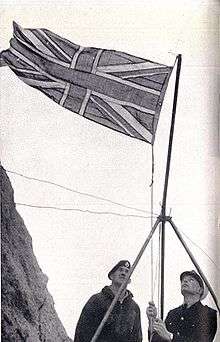HMS Vidal
| History | |
|---|---|
| Name: | HMS Vidal |
| Builder: | Chatham Dockyard |
| Laid down: | 5 July 1950 |
| Launched: | 31 July 1951 |
| Completed: | 29 March 1954 |
| Commissioned: | 1954 |
| Fate: | Broken up in June 1976 |
| General characteristics | |
| Class and type: | Survey ship |
| Displacement: | 1,940 tonnes |
| Length: | 297 ft (91 m) |
| Beam: | 40 ft (12 m) |
| Propulsion: |
|
| Speed: | 16 knots |
| Complement: | 161 |
| Armament: |
|
| Aircraft carried: | 1 × Westland Dragonfly helicopter |
HMS Vidal was a survey ship of the Royal Navy.
Construction and naming
Vidal was built at Chatham Dockyard, and was the last surface vessel, and the last oceanographic survey vessel built at the Dockyard.[1] She was also the first small ship designed to carry a helicopter.[2] She was launched on 31 July 1951 and commissioned into service in 1954. In common with most of the survey ships of the period, she was named after an influential surveyor or explorer of the Royal Navy. In her case, this was the nineteenth century surveyor Alexander Thomas Emeric Vidal, who had surveyed much of the coast of Africa, and ranged into the Atlantic to survey the tiny islet of Rockall.[3] So far she has been the only ship of the Navy to bear the name.[4]


Career
Vidal spent her career carrying out surveys for the Navy, and supporting scientific work for the British government. The development of the Cold War led the British government to decide to formally annex Rockall.[5] This was authorised on 14 September 1955, with orders from Queen Elizabeth II transmitted to the Vidal detailing
On arrival at Rockall you will effect a landing and hoist the Union flag on whatever spot appears most suitable or practicable and you will then take possession of the island on our behalf.[6]
The Vidal arrived in position the following day, but were unable to land any men as poor weather prevented the helicopter from flying.
On 18 September 1955 at precisely 10.16 am, Lieutenant-Commander Desmond Scott RN, Sergeant Brian Peel RM, Corporal AA Fraser RM, and James Fisher (a civilian naturalist and former Royal Marine), were deposited on the island by a Royal Navy helicopter from HMS Vidal. The team cemented in a brass plaque on Hall's Ledge and hoisted the Union Flag to stake the UK's claim.
The inscription on the plaque read:
By authority of Her Majesty Queen Elizabeth II, by the Grace of God of the United Kingdom of Great Britain and Northern Ireland and of her other realms and territories Queen, Head of the Commonwealth, Defender of the Faith, and in accordance with Her Majesty's instructions dated the 14th day of September, 1955, a landing was effected this day upon this island of Rockall from HMS Vidal. The Union flag was hoisted and possession of the island was taken in the name of Her Majesty. [Signed] R H Connell, Captain, HMS Vidal, 18 September 1955.
The plaque was still in place in 1997,when the rock was visited by Greenpeace protesters,[7] but was found to be missing some years later - presumably a victim of the harsh weather.
The formal annexation of Rockall was announced by the Admiralty on 21 September 1955.
In 1964 Vidal carried the Chief Hydrographer, Admiral Sir Edmund Irving to Leningrad for talks with Admiral Anatoliy Rassokho, his counterpart in the Soviet Union.[8] In 1967 she transported scientists and personnel to Diego Garcia.[9]
The Vidal was broken up in Bruges in June 1976.
Notes
- ↑ Image and information on HMS Vidal
- ↑ History of the Fleet Air Arm
- ↑ Dawson. Memoirs of Hydrography. pp. 94–5.
- ↑ Colledge. Ships of the Royal Navy. p. 374.
- ↑ Sharma. Territorial Acquisition. p. 63.
- ↑ BBC.co.uk - 1955: Britain claims Rockall
- ↑ The Guardian 1/1/2011
- ↑ History of the Vidals
- ↑ Stories about Diego Garcia
References
- Colledge, J. J.; Warlow, Ben (2006) [1969]. Ships of the Royal Navy: The Complete Record of all Fighting Ships of the Royal Navy (Rev. ed.). London: Chatham Publishing. ISBN 978-1-86176-281-8. OCLC 67375475.
- Dawson, Llewellyn Styles. "Vice-Admiral A. E. T. Vidal, R. N.". Memoirs of Hydrography: Including Brief Biographies of the Principal Officers who Have Served in H.M. Naval Surveying Service Between the Years 1750 and 1885: Part I: 1750-1830. H.W. Keay. pp. 94–5.
- Sharma, Surya Prakash (1997). Territorial Acquisition, Disputes, and International Law: Territorial Acquisition, Disputes and International Law. Martinus Nijhoff Publishers. p. 63.